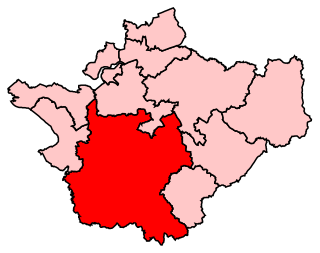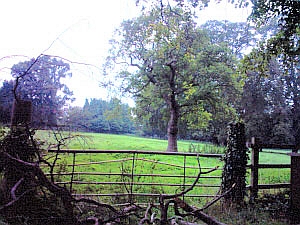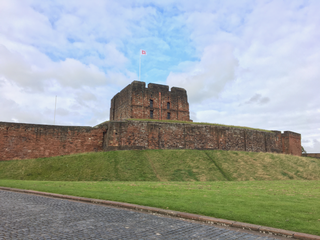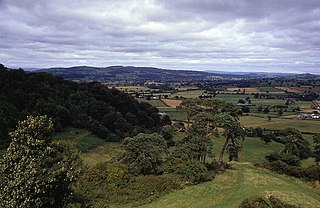Related Research Articles
The Battle of Nantwich was fought on 25 January 1644 in Cheshire during the First English Civil War. In the battle, Sir Thomas Fairfax in command of a Parliamentarian relief force defeated Lord Byron and the Royalists.

Eddisbury is a constituency in Cheshire represented in the House of Commons of the UK Parliament since 2019 by Edward Timpson, a Conservative.
Tarvin is a village in the unitary authority of Cheshire West and Chester and the ceremonial county of Cheshire, England. It had a population of 2,693 people at the 2001 UK census, rising to 2,728 at the 2011 Census, and the ward covers about 17 square miles (44 km2).

The Battle of Rowton Heath, also known as the Battle of Rowton Moor, occurred on 24 September 1645 during the English Civil War. Fought by the Parliamentarians, commanded by Sydnam Poyntz, and the Royalists under the personal command of King Charles I, it was a significant defeat for the Royalists with heavy losses and prevented Charles from relieving the siege of Chester.
The First Battle of Middlewich took place on 13 March 1643, during the First English Civil War, and was fought between the Parliamentarians, under Sir William Brereton, and the Royalist supporters of King Charles I of England, under Sir Thomas Aston.
The Second Battle of Middlewich was a battle of the First English Civil War that took place on 26 December 1643 in Cheshire County. In the battle, Lord Byron and the Royalists defeated a Parliamentarian army commanded by Sir William Brereton.

Nantwich was a parliamentary constituency in Cheshire which returned one Member of Parliament (MP) to the House of Commons of the Parliament of the United Kingdom, elected using the first-past-the-post voting system.
The Bunbury Agreement of December 23, 1642 was drawn up by some prominent gentlemen of the county of Cheshire to keep Cheshire neutral during the English Civil War. It was never ratified by the national leadership of either side and failed to keep the war out of Cheshire, because the national strategic importance of Cheshire and of the city port of Chester meant that national interests overruled local ones.

The siege of Carlisle occurred during the First English Civil War when the allied forces of the Scottish Covenanters and the English Parliamentarians besieged Carlisle Castle which was held at the time by the English Royalist forces loyal to King Charles I. The siege took place in Carlisle, Cumbria from October 1644 to 25 June 1645.
The Relief of Newark was a Royalist victory during the First English Civil War. It was a personal victory for Prince Rupert and it resulted in the Royalists holding Newark-on-Trent until very near the end of the war.
The Storming of Bolton, sometimes referred to as the "Bolton massacre", was an event in the First English Civil War which happened on 28 May 1644. The strongly Parliamentarian town was stormed and captured by Royalist forces under Prince Rupert. It was alleged that up to 1,600 of Bolton's defenders and inhabitants were slaughtered during and after the fighting. The "massacre at Bolton" became a staple of Parliamentarian propaganda.

Sir William Vaughan was a cavalry officer in the armies of Charles I of England. Initially serving in Ireland during the Confederate Wars, the outbreak of the First English Civil War led to him being sent to England in 1644, at the head of an Anglo-Irish cavalry regiment, to reinforce the Royalist army.

Robert Venables, was an English soldier from Cheshire, who fought for Parliament in the 1638 to 1651 Wars of the Three Kingdoms, and captured Jamaica in 1655.

Sir Vincent Corbet, 1st Baronet was an English lawyer and politician who sat for Shropshire in the House of Commons in the Short Parliament of 1640. He fought on the Royalist side in the English Civil War.

The siege of Chester occurred over a 16-month period between September 1644 and February 1646 during the First English Civil War. In the engagement, Sir William Brereton and the Parliamentarians were ultimately successful in taking possession of the city and Royalist garrison commanded by Lord Byron.

The Battle of Montgomery took place during the First English Civil War of 1642–1646. On 17 September 1644, a Parliamentarian force commanded by Sir John Meldrum advanced to engage a Royalist army led by Lord Byron which was besieging Montgomery Castle in mid Wales. The battle was fought the next day. After the Royalists gained an initial advantage, the Parliamentarians counter-attacked and destroyed Byron's army.
The Battle of Ormskirk was fought on 20 August 1644 during the First English Civil War. It was a decisive victory for the Parliamentarian force commanded by Major-General Sir John Meldrum over the Royalist force commanded by Lord Byron.
Edward Burghall was an English ejected minister, a Puritan who supported the Parliamentary cause in the English Civil War. He is known for a diary called "Providence improved", which describes the state of Cheshire throughout the English Civil War. From this diary the main facts of Burghall's life can also be gathered.
The Battle of Stourbridge Heath was a skirmish that took place during the First English Civil War, in which a Parliamentarian contingent under the command of Colonel "Tinker" Fox was defeated by a larger Royalist force under the command of Sir Gilbert Gerard, Governor of Worcester.

The Battle of Oswestry took place during the First English Civil War on 22-23 June 1644 when Parliamentarians led by Lord Denbigh attacked and took control of the Royalist garrison in Oswestry, Shropshire.
References
- Burghall, Edward (1778), "Providence improved", in Anonymous (ed.), The History of Cheshire: Containing King's Vale-royal Entire, vol. 2, pp. 931–932, 936–937 942
- Hanshall, J.H. (1817), The history of the county palatine of Chester, Printed by John Fletcher and sold by Arthur K'all bookseller, p. 456
- Lysons, Daniel (1810), Magna Britannia: pt. 1. Cambridgeshire. pt. 2. The county palatine of Chester, vol. 2, part 2, T. Cadell and W. Davies, p. 749
- Malbon, Thomas (1657), Malbon's Memorial of the Civil War. (Cowper Mss.), archived from the original on 27 October 2009